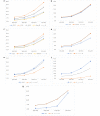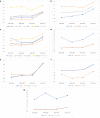The impacts of the scope of benefits expansion on hospice care among adult decedents: a nationwide longitudinal observational study
- PMID: 36978057
- PMCID: PMC10053103
- DOI: 10.1186/s12904-023-01146-z
The impacts of the scope of benefits expansion on hospice care among adult decedents: a nationwide longitudinal observational study
Abstract
Objectives: Compared to aggressive treatment for patients at the end stage of life, hospice care might be more likely to satisfy such patients' need and benefits and improve their dignity and quality of life. Whether the reimbursement policy expansion affect the use of hospice care among various demographics characteristics and health status was unknown. Therefore, the purpose of this study was to explore the impacts of reimbursement policy expansion on hospice care use, and to investigate the effects on people with various demographics characteristics and health status.
Methods: We used the 2001-2017 Taiwan NHI claims data, Death Registry, and Cancer Registry in this study, and we included people who died between 2002 and 2017. The study period was divided into 4 sub-periods. hospice care use and the initiation time of 1st hospice care use were used as dependent variables; demographic characteristics and health status were also collected.
Results: There were 2,445,781 people who died in Taiwan during the study period. The results show that the trend of hospice care use increased over time, going steeply upward after the scope of benefits expansion, but the initiation time of 1st hospice care use did not increase after the scope of benefits expansion. The results also show that the effects of expansion varied among patients by demographic characteristics.
Conclusion: The scope of benefits expansion might induce people's needs in hospice care, but the effects varied by demographic characteristics. Understanding the reasons for the variations in all populations would be the next step for Taiwan's health authorities.
Keywords: Health Care utilization; Hospice care; Population characteristics.
© 2023. The Author(s).
Conflict of interest statement
The authors declare that they have no competing interests.
The authors certify that there is no conflict of interest with any financial organization regarding the materials discussed in the manuscript.
Figures


Similar articles
-
A population-based study on the determinants of hospice utilization in the last year of life for Taiwanese cancer decedents, 2001-2006.Psychooncology. 2010 Nov;19(11):1213-20. doi: 10.1002/pon.1690. Psychooncology. 2010. PMID: 20119936
-
Effects of hospice-shared care on terminal cancer patients in Taiwan: A hospital-based observational study.Eur J Oncol Nurs. 2024 Apr;69:102525. doi: 10.1016/j.ejon.2024.102525. Epub 2024 Feb 5. Eur J Oncol Nurs. 2024. PMID: 38340644
-
Impact of availability of an inpatient hospice unit on the parent hospital's quality of palliative care for Taiwanese cancer decedents, 2001-2006.J Pain Symptom Manage. 2011 Sep;42(3):400-9. doi: 10.1016/j.jpainsymman.2010.12.011. Epub 2011 Mar 31. J Pain Symptom Manage. 2011. PMID: 21458221
-
Dignity in end-of-life care at hospice: An Action Research Study.Scand J Caring Sci. 2021 Jun;35(2):420-429. doi: 10.1111/scs.12872. Epub 2020 May 17. Scand J Caring Sci. 2021. PMID: 32419195 Review.
-
End-of-life and hospice care for neurologic illness.Handb Clin Neurol. 2022;190:195-215. doi: 10.1016/B978-0-323-85029-2.00006-3. Handb Clin Neurol. 2022. PMID: 36055716 Review.
Cited by
-
Factors influencing accessibility of palliative care: a systematic review and meta-analysis.BMC Palliat Care. 2025 Mar 24;24(1):80. doi: 10.1186/s12904-025-01704-7. BMC Palliat Care. 2025. PMID: 40128834 Free PMC article.
References
Publication types
MeSH terms
Grants and funding
LinkOut - more resources
Full Text Sources
Medical

